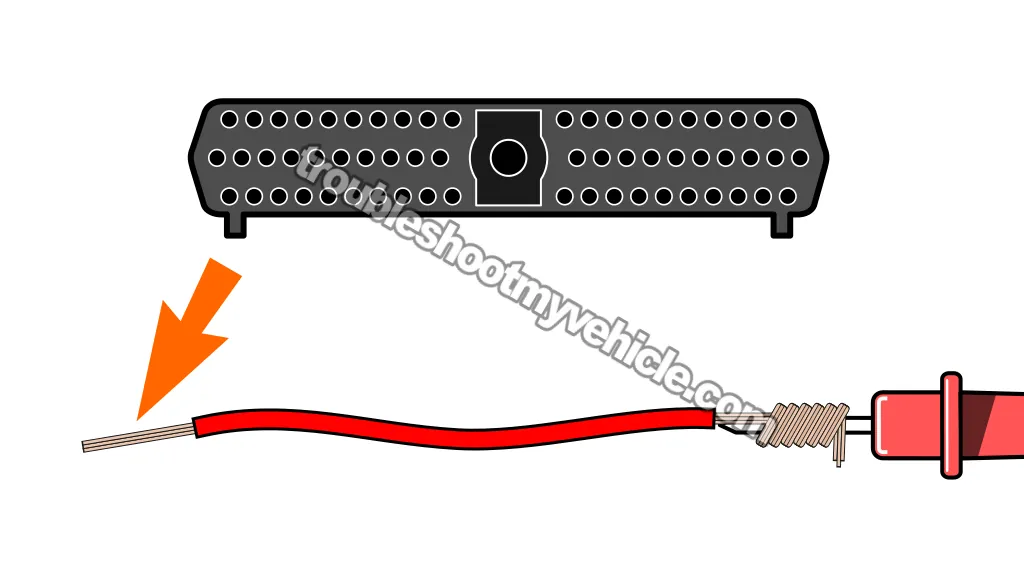
Sooner or later, working on your vehicle's wiring often means testing circuits directly at the PCM connector —but probing those delicate terminals the wrong way can cause serious damage.
One wrong move and you could deform a pin, break the weather seal, or create long-term drivability issues!
In this guide, I'll show you what not to do —and more importantly, a low-cost, safe method I've used for years that works just as well as the expensive tools.
Contents of this tutorial:
APPLIES TO: This tutorial applies to the following vehicles:
- 1989-1993:
- Dodge Ram 150 Pickup 5.2L V8: 1989, 1990, 1991, 1992, 1993.
- Dodge Ram 250 Pickup 5.2L V8: 1989, 1990, 1991, 1992, 1993.
- Dodge Ram 150 Pickup 5.9L V8: 1989, 1990, 1991, 1992, 1993.
- Dodge Ram 250 Pickup 5.9L V8: 1989, 1990, 1991, 1992, 1993.
- Dodge Ram 350 Pickup 5.9L V8: 1989, 1990, 1991, 1992, 1993.
- 1994-2003:
- Dodge Ram 1500 Pickup 5.2L V8: 1994, 1995, 1996, 1997, 1998, 1999, 2000, 2001.
- Dodge Ram 2500 Pickup 5.2L V8: 1994, 1995, 1996, 1997, 1998.
- Dodge Ram 1500 Pickup 5.9L V8: 1994, 1995, 1996, 1997, 1998, 1999, 2000, 2001, 2002, 2003.
- Dodge Ram 2500 Pickup 5.9L V8: 1994, 1995, 1996, 1997, 1998, 1999, 2000, 2001, 2002.
- Dodge Ram 3500 Pickup 5.9L V8: 1994, 1995, 1996, 1997, 1998, 1999, 2000, 2001, 2002, 2003.
What I Don't Do (And Why)
Whenever I need to probe a PCM connector pin (like during a circuit continuity test) I use thin, precision probes made specifically for this job.
The safest option is to use a dedicated terminal testing probe, like the ones in the following links:
- AUTOOL 68PCS Multimeter Test Leads Kit (at: amazon.com).
- LUTIFIX 68PCS Automotive Circuit Test Leads Kit (at: amazon.com).
I never insert standard multimeter leads directly into the round female terminals of the PCM connector. Those terminals are very small, and most multimeter probes are too thick.
Forcing them in can easily deform or damage the terminal, opening up a whole new can of worms —causing poor contact, weird drivability issues, or even total circuit failure.
Unfortunately, those thin precision probes usually have to be bought online and can be expensive, which puts them out of reach for many DIYers.
Why I Avoid Back-Probing PCM Connectors:
I also avoid using back probes on PCM connectors, even though that's a common method. Since the PCM sits in the engine compartment, those connectors use weather-sealed terminals to keep out moisture and debris.
Back-probing means inserting the probe at the rear of the connector, which can damage the rubber seal around the wire and create a permanent path for moisture to enter.
That tiny hole might not seem like a big deal now, but over time it can lead to corrosion inside the terminal, poor connections, and eventually circuit failure —especially in an environment exposed to heat, vibration, and weather. To me, it's just not worth the risk.
The Safe, Low-Cost Method I Use

Here's the simple, reliable, and DIY-friendly way that I've used to safely probe a PCM connector without damaging the terminal or the seal:
- Find a small piece of scrap wire —about 3 to 4 inches long. I use a wire from an old engine harness. Any automotive-grade wire you have lying around should work fine.
- Strip about ½ to 1 inch of insulation from both ends of the wire.
- On one end, wrap the exposed copper strands tightly around the metal tip of your multimeter test lead. This gives you a solid connection.
- Wrap a small strip of electrical tape around the test lead where the copper strands are wrapped.
- This helps secure the connection and insulates it, preventing the exposed wire from accidentally touching metal and skewing your reading.
- On the other end, insert the bare copper into the PCM connector terminal from the front (the same side the PCM plugs in —not the back).
- If the wire has too many strands to fit easily, trim a few off with wire cutters so it slides in with just enough resistance to make good contact.
- Make sure the fit is snug but not forced. The goal is gentle, solid contact —not a tight press that risks spreading the terminal.
This method gives you a clean, solid connection to the PCM terminal with no risk of spreading or damaging the terminal. Once you're done testing, simply remove the wire and plug the connector back in as usual.
Remember, the key is to never jam oversized probes into these sensitive PCM connectors. A little patience and the right technique will save you from costly mistakes.
Always Disconnect The Battery Before Working On The PCM Connector
Any time you're disconnecting or reconnecting the PCM connector —or performing any test involving its terminals— you have to first disconnect the battery negative (–) cable from the battery.
This isn't just a best practice —it's essential for protecting sensitive electronics. The PCM contains internal circuits that can be damaged instantly if voltage is present during connector removal or reinstallation. Even a quick arc or static charge can lead to expensive, avoidable failure.
So, before you touch the PCM connector, remove the key from the ignition, wait a minute or two, and disconnect the battery negative terminal.
Once you've finished your testing or repair, you can reconnect the battery as the final step.
More 5.2L, 5.9L V8 Dodge Ram Pickup Tutorials
I've written several more tutorials for the V8 Dodge Ram pickups that may be of interest to you that you can find in this index:
Here's a sample of the tutorials you'll find in the index:
- Troubleshooting A Blown Head Gasket (1989-2003 5.2L, 5.9L V8 Dodge Ram Pickup).
- How To Test The TPS (1992-1996 5.2L, 5.9L V8 Dodge Ram Pickup).
- How To Test The MAP Sensor (1992-1996 5.2L, 5.9L V8 Dodge Ram Pickup).
- How To Test The Intake Air Temp (IAT) Sensor (1992-1997 5.2L, 5.9L V8 Dodge Ram Pickup).

If this info saved the day, buy me a beer!

